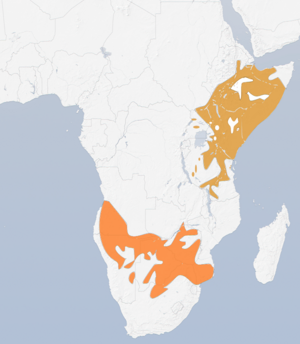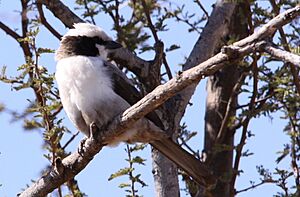Southern white-crowned shrike facts for kids
Quick facts for kids Southern white-crowned shrike |
|
|---|---|
 |
|
| At Marakele National Park, South Africa | |
| Conservation status | |
| Scientific classification | |
| Genus: |
Eurocephalus
|
| Species: |
anguitimens
|
 |
|
Range map for the Eurocephalus shrikes
|
|
The southern white-crowned shrike (Eurocephalus anguitimens) is a special kind of bird. It belongs to the shrike family. You can find this bird in several countries in southern Africa. These include Angola, Botswana, Mozambique, Namibia, South Africa, and Zimbabwe. It likes to live in dry forests and open, dry savannah areas.
Contents
What Does This Bird Look Like?
The southern white-crowned shrike grows to be about 24 centimeters (9.4 inches) long. Both male and female birds look very similar.
Adult Birds
Adult shrikes have a bright white crown and forehead. They have a black "mask" that goes around their eyes and down to their neck. Their back and upper body are a dusty brown color. Their wings and tail are dark brown. The underside of their body is off-white, with a slight buff color on the upper chest. Their lower belly is a dusty brown. They have a black beak, brown eyes, and dark brown legs.
Young Birds
Young shrikes look a lot like the adults. However, their white crown might have some gray spots or stripes. Their chin and throat are white. The rest of their underside has a hint of dusty brown.
How Do They Live?
The southern white-crowned shrike is a very social bird. It is much like its close relative, the northern white-crowned shrike. These birds often live in small, close-knit groups. A group usually has three to six birds. Sometimes, outside of the breeding season, a group can have up to twenty birds.
Behavior and Food
These birds are generally not aggressive. But they will attack predators like birds of prey. When they are looking for food, they sometimes join up with Tockus hornbills. They eat the insects that the hornbills stir up as they walk around.
Cooperative Breeding
Members of a group help each other raise their young. This is called cooperative breeding. They work together to build a nest for their eggs. They take turns sitting on the eggs to keep them warm. They also help feed the baby birds once they hatch.
Are They Safe?
The southern white-crowned shrike lives across a very large area. In some places, it is very common. In other areas, it is rare.
Conservation Status
Experts have not found any major threats to this bird. Its population seems to be stable. Because of this, the International Union for Conservation of Nature says its conservation status is "least concern". This means it is not currently at risk of disappearing.



